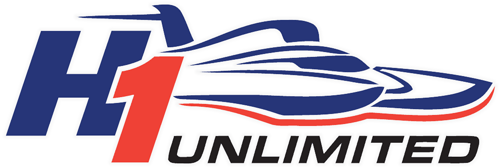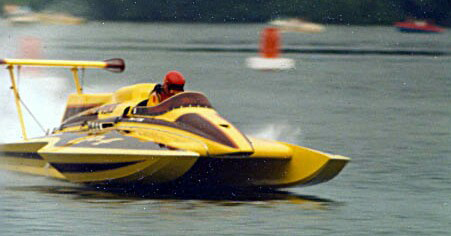History Of Grand Prix Racing
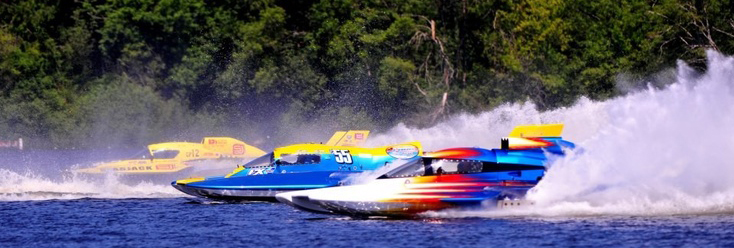 Officials of the H1 Unlimited Hydroplane Series and the Grand Prix West Hydroplane Series recently announced that they have entered into a “Memorandum of Agreement” which will lead to increased participation and exposure for the GPW series at H1 Unlimited events.
Officials of the H1 Unlimited Hydroplane Series and the Grand Prix West Hydroplane Series recently announced that they have entered into a “Memorandum of Agreement” which will lead to increased participation and exposure for the GPW series at H1 Unlimited events.
H1 Unlimited Historian Fred Farley takes a look back at the colorful history of Grand Prix Racing.
GRAND PRIX: IN THE BEGINNING
By Fred Farley
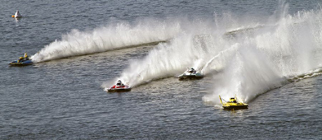 Grand Prix Class hydroplane racing has long been considered the epitome of automotive-powered inboard racing. The sight and sound of these magnificent boats with their souped-up V-8 engines at full song is an experience like no other in motorsports.
Grand Prix Class hydroplane racing has long been considered the epitome of automotive-powered inboard racing. The sight and sound of these magnificent boats with their souped-up V-8 engines at full song is an experience like no other in motorsports.
Grand Prix boats began making their presence felt on the Canadian Boating Federation (CBF) circuit in the 1960s. There was a considerable fleet of them in and around Valleyfield, Quebec. The GPs were an outgrowth of the old 7-Litre Class that rose to prominence in the late 1940s.
Nicknamed “The Big Iron,” these boats were a minimum of 20 feet in length with engines of up to 500 cubic inches in piston displacement. Many were supercharged, and any kind of fuel was permitted.
An early star of Canadian Grand Prix racing was the legendary Art Asbury. Driving Aubert Brillant’s Chrysler-hemi-powered CANADIANA GRAND PRIX, Asbury set a UIM world straightaway record of 153.746 miles per hour in 1965 at Beloeil, Quebec.
The American Power Boat Association (APBA) first took notice of the Grand Prix phenomenon in 1974. The GPs made their United States debut on the narrow Scioto River at Columbus, Ohio. The original winner of a non-Canadian GP race was Larry Lauterbach, driving John Stauffer’s EDELWEISS, designed and built by Larry’s father Henry Lauterbach of Portsmouth, Virginia.
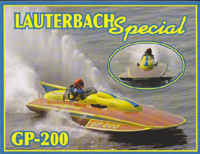 Lauterbach hulls dominated the first few years of Grand Prix racing in the United States. In addition to EDELWEISS, such notable Lauterbach entries included the likes of LAUTERBACH SPECIAL, GOLDEN NUGGET, DEEPWATER SPECIAL, BOOMERANG, ADVANCE UNITED, HEAVY HAULER, and EL CONDOR.
Lauterbach hulls dominated the first few years of Grand Prix racing in the United States. In addition to EDELWEISS, such notable Lauterbach entries included the likes of LAUTERBACH SPECIAL, GOLDEN NUGGET, DEEPWATER SPECIAL, BOOMERANG, ADVANCE UNITED, HEAVY HAULER, and EL CONDOR.
No one ever complained about the quality of workmanship on a Lauterbach hull! These boats were built strong to last long! And they loved horsepower! These were conventional hulls with the driver sitting behind–rather than ahead of–the engine well.
At a time when the sport in general was changing over to cabover–or forward-cockpit–hulls, popularized by Ron Jones, Sr., the old-style Lauterbach hulls remained surprisingly competitive.
Some of the biggest names in boat racing associated with Grand Prix racing in the early days. Many of these made reputations for themselves in Unlimited hydroplanes as well. These included Larry Lauterbach, Chip Hanauer, Tom D’Eath, Jim Kropfeld, Howie Benns, John Prevost, Ron Snyder, and Terry Turner.
The class received its first major league shot in the arm in 1977 in Detroit, where they performed before an audience of a quarter million. The Spirit Of Detroit Association (SODA) invited the GPs to be the co-feature together with the Unlimiteds. This race came about largely through the efforts of SODA board member John Love. Love had attended several Canadian Grand Prix races with his friend Tom D’Eath and was impressed with the competitiveness of the Grand Prix Class.
Love soon became GP Chairman for APBA. Nicknamed “The Boy Commissioner,” John did much to smooth out the differences between the APBA and CBF factions of Grand Prix. No longer was conflicting race dates assigned to the detriment of all. More teams from both countries began patronizing each others races.
Terry Turner won the first Detroit GP race with LAUTERBACH SPECIAL. It was the first time that the Unlimited Class and the Grand Prix Class had ever occupied the same pit area with each other. It would not be the last. Turner defeated such formidable challengers as Stover Hire in MOONSHOT, New Zealand Champion Peter Knight in GONE HEAVY, “crown/clown prince” Jules LeBoeuf in BOOMERANG, and Bill Hodge in LONG GONE.
Turner and the Chevy-powered LAUTERBACH SPECIAL likewise won the GP race at Madison, Indiana, and went on to claim the Grand Prix Class National High Point Championship in 1977. They had stiff opposition from the Ron Jones-designed LONG GONE, which won that year’s Guadalajara, Mexico, and Mexico City, Mexico, Grand Prix races.
The Chrysler Hemi-powered LONG GONE emerged as season points champion in 1978. LAUTERBACH SPECIAL, co-driven by Chip Hanauer and Tom D’Eath, was back on top in 1979.
Perhaps the most eloquent showcase of Grand Prix racing in the early days of the class was the GP Nationals on the Ohio River at Owensboro, Kentucky, in 1979. Hanauer and LAUTERBACH SPECIAL, owned by Don Ryan, reeled off three first places in as many heats to claim the title.
The start of the Final Championship Heat was close with four boats pouring into the tight first turn together. LAUTERBACH SPECIAL and DEEPWATER TOO with Tom Baker duked it out down the backstretch with Baker keeping the pressure on Hanauer until hull damage forced the DEEPWATER entry out of the race.
Marty Niles stayed in contention with OLYMPIAD but was disqualified for missing a marker. Tom “Butch” Kropfeld and GOLDEN NUGGET took runner-up, and Bill Hodge finished third with LONG GONE.
Defending champion Larry Lauterbach, who had captured the 1978 GP Nationals at the Minneapolis Aquatennial Regatta, never recovered from a late start with PEANUT and managed only a fourth in the furious competition, ahead of Ty Cobb in FLYIN’ LOW and 62-year-old Paul Bauer in BIG KAT-N-NAN V.
Hanauer posted heat times of 100.334, 94.467, and 99.938 in the Bellingham, Washington-based entry. Fastest heat of the day went to Baker and DEEPWATER TOO, who did 101.930 in the 2-B section. Hodge and LONG GONE also cleared the century mark with a 100.649 reading in 1-B.
Grand Prix boats of today have little in common with their predecessors of yesteryear. A modern GP craft is a technological marvel with a cabover configuration and an aircraft-style safety canopy.
A 1970s GP was, more often than not, a beefed-up 7-Litre with the driver sitting behind the engine in an open cockpit.
Given the increasing number of active boats in recent years, the Grand Prix clan’s best sale point is an individual heat of racing. That is when the level of competition can be absolutely incredible–hardcore, auto-powered race boating at its gut-wrenching best.
Some of the finest inboard teams around the world are flocking to join “The Big Iron.” The real winners, the fans, eagerly await the results.
History Of Grand Prix Racing
 Officials of the H1 Unlimited Hydroplane Series and the Grand Prix West Hydroplane Series recently announced that they have entered into a “Memorandum of Agreement” which will lead to increased participation and exposure for the GPW series at H1 Unlimited events.
Officials of the H1 Unlimited Hydroplane Series and the Grand Prix West Hydroplane Series recently announced that they have entered into a “Memorandum of Agreement” which will lead to increased participation and exposure for the GPW series at H1 Unlimited events.
H1 Unlimited Historian Fred Farley takes a look back at the colorful history of Grand Prix Racing.
GRAND PRIX: IN THE BEGINNING
By Fred Farley
 Grand Prix Class hydroplane racing has long been considered the epitome of automotive-powered inboard racing. The sight and sound of these magnificent boats with their souped-up V-8 engines at full song is an experience like no other in motorsports.
Grand Prix Class hydroplane racing has long been considered the epitome of automotive-powered inboard racing. The sight and sound of these magnificent boats with their souped-up V-8 engines at full song is an experience like no other in motorsports.
Grand Prix boats began making their presence felt on the Canadian Boating Federation (CBF) circuit in the 1960s. There was a considerable fleet of them in and around Valleyfield, Quebec. The GPs were an outgrowth of the old 7-Litre Class that rose to prominence in the late 1940s.
Nicknamed “The Big Iron,” these boats were a minimum of 20 feet in length with engines of up to 500 cubic inches in piston displacement. Many were supercharged, and any kind of fuel was permitted.
An early star of Canadian Grand Prix racing was the legendary Art Asbury. Driving Aubert Brillant’s Chrysler-hemi-powered CANADIANA GRAND PRIX, Asbury set a UIM world straightaway record of 153.746 miles per hour in 1965 at Beloeil, Quebec.
The American Power Boat Association (APBA) first took notice of the Grand Prix phenomenon in 1974. The GPs made their United States debut on the narrow Scioto River at Columbus, Ohio. The original winner of a non-Canadian GP race was Larry Lauterbach, driving John Stauffer’s EDELWEISS, designed and built by Larry’s father Henry Lauterbach of Portsmouth, Virginia.
 Lauterbach hulls dominated the first few years of Grand Prix racing in the United States. In addition to EDELWEISS, such notable Lauterbach entries included the likes of LAUTERBACH SPECIAL, GOLDEN NUGGET, DEEPWATER SPECIAL, BOOMERANG, ADVANCE UNITED, HEAVY HAULER, and EL CONDOR.
Lauterbach hulls dominated the first few years of Grand Prix racing in the United States. In addition to EDELWEISS, such notable Lauterbach entries included the likes of LAUTERBACH SPECIAL, GOLDEN NUGGET, DEEPWATER SPECIAL, BOOMERANG, ADVANCE UNITED, HEAVY HAULER, and EL CONDOR.
No one ever complained about the quality of workmanship on a Lauterbach hull! These boats were built strong to last long! And they loved horsepower! These were conventional hulls with the driver sitting behind–rather than ahead of–the engine well.
At a time when the sport in general was changing over to cabover–or forward-cockpit–hulls, popularized by Ron Jones, Sr., the old-style Lauterbach hulls remained surprisingly competitive.
Some of the biggest names in boat racing associated with Grand Prix racing in the early days. Many of these made reputations for themselves in Unlimited hydroplanes as well. These included Larry Lauterbach, Chip Hanauer, Tom D’Eath, Jim Kropfeld, Howie Benns, John Prevost, Ron Snyder, and Terry Turner.
The class received its first major league shot in the arm in 1977 in Detroit, where they performed before an audience of a quarter million. The Spirit Of Detroit Association (SODA) invited the GPs to be the co-feature together with the Unlimiteds. This race came about largely through the efforts of SODA board member John Love. Love had attended several Canadian Grand Prix races with his friend Tom D’Eath and was impressed with the competitiveness of the Grand Prix Class.
Love soon became GP Chairman for APBA. Nicknamed “The Boy Commissioner,” John did much to smooth out the differences between the APBA and CBF factions of Grand Prix. No longer was conflicting race dates assigned to the detriment of all. More teams from both countries began patronizing each others races.
Terry Turner won the first Detroit GP race with LAUTERBACH SPECIAL. It was the first time that the Unlimited Class and the Grand Prix Class had ever occupied the same pit area with each other. It would not be the last. Turner defeated such formidable challengers as Stover Hire in MOONSHOT, New Zealand Champion Peter Knight in GONE HEAVY, “crown/clown prince” Jules LeBoeuf in BOOMERANG, and Bill Hodge in LONG GONE.
Turner and the Chevy-powered LAUTERBACH SPECIAL likewise won the GP race at Madison, Indiana, and went on to claim the Grand Prix Class National High Point Championship in 1977. They had stiff opposition from the Ron Jones-designed LONG GONE, which won that year’s Guadalajara, Mexico, and Mexico City, Mexico, Grand Prix races.
The Chrysler Hemi-powered LONG GONE emerged as season points champion in 1978. LAUTERBACH SPECIAL, co-driven by Chip Hanauer and Tom D’Eath, was back on top in 1979.
Perhaps the most eloquent showcase of Grand Prix racing in the early days of the class was the GP Nationals on the Ohio River at Owensboro, Kentucky, in 1979. Hanauer and LAUTERBACH SPECIAL, owned by Don Ryan, reeled off three first places in as many heats to claim the title.
The start of the Final Championship Heat was close with four boats pouring into the tight first turn together. LAUTERBACH SPECIAL and DEEPWATER TOO with Tom Baker duked it out down the backstretch with Baker keeping the pressure on Hanauer until hull damage forced the DEEPWATER entry out of the race.
Marty Niles stayed in contention with OLYMPIAD but was disqualified for missing a marker. Tom “Butch” Kropfeld and GOLDEN NUGGET took runner-up, and Bill Hodge finished third with LONG GONE.
Defending champion Larry Lauterbach, who had captured the 1978 GP Nationals at the Minneapolis Aquatennial Regatta, never recovered from a late start with PEANUT and managed only a fourth in the furious competition, ahead of Ty Cobb in FLYIN’ LOW and 62-year-old Paul Bauer in BIG KAT-N-NAN V.
Hanauer posted heat times of 100.334, 94.467, and 99.938 in the Bellingham, Washington-based entry. Fastest heat of the day went to Baker and DEEPWATER TOO, who did 101.930 in the 2-B section. Hodge and LONG GONE also cleared the century mark with a 100.649 reading in 1-B.
Grand Prix boats of today have little in common with their predecessors of yesteryear. A modern GP craft is a technological marvel with a cabover configuration and an aircraft-style safety canopy.
A 1970s GP was, more often than not, a beefed-up 7-Litre with the driver sitting behind the engine in an open cockpit.
Given the increasing number of active boats in recent years, the Grand Prix clan’s best sale point is an individual heat of racing. That is when the level of competition can be absolutely incredible–hardcore, auto-powered race boating at its gut-wrenching best.
Some of the finest inboard teams around the world are flocking to join “The Big Iron.” The real winners, the fans, eagerly await the results.

